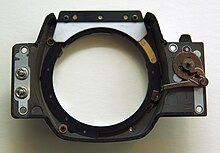Aperture transmission

In camera systems with interchangeable lenses, aperture transmission (also: aperture simulator or Blesator ) is a process with which the value of the aperture number set on the lens is transmitted electrically or mechanically to the exposure measurement in the camera.
Depending on the setting of the lens aperture, more or less light reaches the recording medium from the object, be it a conventional film or a digital image sensor, which must be taken into account when setting the exposure. In all modern SLR cameras with integrated exposure system which takes metering by the mounted lens. In early camera models, this so-called internal measurement was basically carried out with the working aperture set on the lens for the respective exposure, which, depending on the dimming, led to a more or less dark viewfinder image at the time of measurement. In addition, the long-widespread CdS measuring cells work very slowly at low brightness, precise exposure measurement with low lighting intensity and at the same time strongly dimmed lens can take several seconds or even be impossible.
These disadvantages can be avoided by measuring the exposure with the aperture open . A mechanical or electrical control keeps the aperture open before taking the picture, regardless of the value set on the aperture ring, so that all settings can always be made at full viewfinder brightness. The exposure meter actually receives incorrect brightness values as a result. The aperture transmission therefore provides the exposure meter with the necessary information about which working aperture to expect when the camera is triggered. This information is set off inside the camera with the measured brightness value. Depending on the version of the camera, this calculation can be purely mechanical, with analog electronics or digitally.
